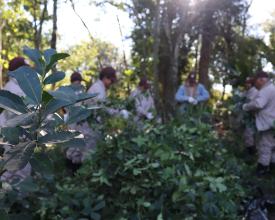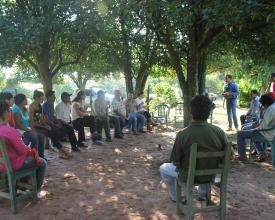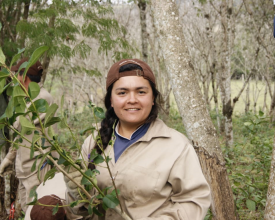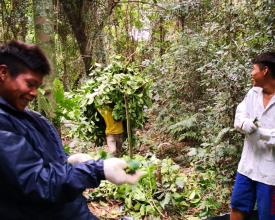
The tea that reborns the Atlantic Forest: Yerba mate, culture and biodiversity.
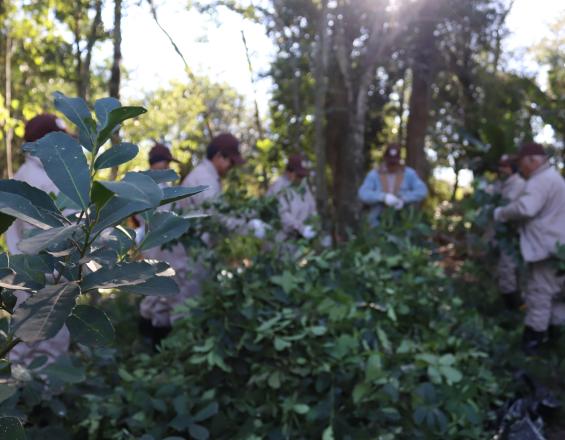
The Atlantic Forest is considered one of the most biodiverse tropical forests on the planet (biodiversity hotspot), the second largest in South America and the first Important Bird Area (IBA) of Paraguay with high endemism of birds and endangered species. Currently the development of extensive agriculture and urbanization has reduced its original coverage to less than 7% of the area in Paraguay. San Rafael has been widely recognized as the main conservation priority of the Atlantic Forest in Paraguay. The solution for its long-term conservation and to avoid the loss of connectivity with other important areas of the Atlantic Forest, consists of an innovative production model based on the recovery of degraded areas of the Atlantic Forest in the area of influence of San Rafael with Ilex paraguariensis - yerba mate with other native species, promoting its natural and cultural conservation, as well as the economic viability of rural and indigenous communities.
Context
Challenges addressed
1. That producers can achieve sustainability of the model through a governance mechanism and continue negotiations for the value chain with autonomy.
2. To remove mechanized production practices and extensive yerba mate monoculture.
3. Availability of technicians specialized in the production model.
3. Anthropic and natural threats in the territory that affect production, such as forest fires, deforestation, agrochemical contamination.
Location
Process
Summary of the process
The Atlantic Forest can be restored using the benefits of the shaded organic yerba mate production model, which enriches degraded areas by promoting regenerative agriculture.
The populations of the area have ancestral use of yerba mate as part of their cultural practices. Providing economic viability to the communities by implementing a production model that combines ancestral techniques, with an incipient market and with the support of local governments and production associations, ensures the sustainability of their local livelihoods.
Building Blocks
Regenerative Agriculture
The production of yerba mate under shade is a model in which yerba mate - Ilex paraguariensis - is grown in degraded or totally deforested areas of the Atlantic Forest, during the production cycle it is enriched with other native tree species to generate shade and the ground cover is preserved with biomass, it is replicable in the Atlantic Forest region.Indigenous Mbya Guaraní communities have ancestrally managed yerba mate without greatly disturbing the forest, and this model combines ancestral techniques with modern agroecology.
Enabling factors
Yerba mate is traditionally produced extensively, without forest cover and with the use of chemicals that degrade soils. As it is a native species of the Atlantic Forest, its organic production in degraded forests favors the resistance of the species, the quality of the plant, the enrichment with native forest species and makes it possible to rescue and implement ancestral techniques of yerba mate production with a minimum impact on the native forest.
Lesson learned
1. Since this is an innovative production model that combines traditional and ancestral yerba mate management techniques, a period of years of technical support is required to install the model and empower producers to continue with the production model.
2. The model should not be implemented in forests in a good state of conservation; it should be expanded in areas with a high degradation index within the Atlantic Forest ecoregion, since the production system seeks to gain areas of organic and agroecological production while recovering forest cover.
2. Climatic conditions are a determining factor for obtaining inputs such as seedlings, seeds and others.
Sustainable livelihoods
The shade-grown yerba mate model generates profitable economic income from the added value of recovering forests while maintaining traditional organic customs and practices around yerba mate. Ancestral Guarani techniques are combined with modern low-impact agroecological management techniques for yerba mate production. The market for organic yerba mate continues to grow annually as a nutritious foodstuff and international markets are in high demand.
Enabling factors
There is a culture related to the management of yerba mate in the area; rural communities were already cultivating under the traditional model.
The private yerba mate sector is concentrated in the area where the solution will be implemented, which allows for the establishment of alliances with the national yerba mate association.
There is a commitment from local governments to support the development of the model, as it is a local industry.
Lesson learned
For yerba mate production to be successful, it must be combined with other crops that currently contribute to the livelihoods of local people in a diversified organic farm model.
The producers are in the process of forming an Association after 5 years of starting the initiative. Accompaniment and training should be planned over a period of several years to empower and organize rural and indigenous producers to govern the value chain.
Impacts
1. Generation of competitive economic income per hectare and with added value for rural and indigenous communities in the area of influence.
2. Recovery of degraded areas of Atlantic Forest: vegetation cover, humidity, mutualism with other native species of ecological value.
3. Restoration of the connectivity of large forest masses through the agroforestry system.
4. Increase in the quality of life of rural and indigenous communities: fair labor, use of the forest's ecosystem services.
5. Cultural roots: recovery of traditional and ancestral techniques of yerba mate production by the settlers, increase in youth employment.
Beneficiaries
61 families from 5 communities of family farmers: Oga Ita, Joveré, Cerro Guy and Perlita plus the indigenous Mbya Guarani community of Arroyo Morotĩ of approximately 150 people are directly benefited.
Sustainable Development Goals
Story
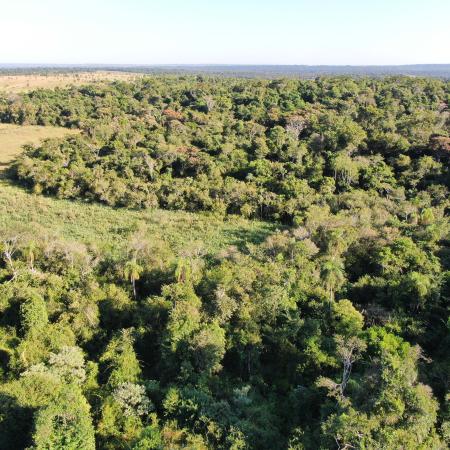
If I told you that we could protect one of the most threatened biomes in the world just by sharing a cup of tea, would you believe me?
Of course, it is not just any kind of tea, it is an ancestral drink of the Guarani Indians and it is my national drink. It is yerba mate, a plant that belongs to the Atlantic Forest, one of the most diverse sub-humid forests in the world with a high endemism of flora and fauna, but also one of the most endangered. Fragmentation due to fires, illegal activities and unsustainable practices mean that now only 7% of the original cover of this forest remains. But what are we doing about it? We started a native agroforestry system with yerba mate under shade in degraded forests in the buffer zone of the San Rafael National Park, the most important remnant of Atlantic Forest in Paraguay, with 5 peasant communities and 1 Mbya Guarani indigenous community. We are able to market under organic and fair trade certification and currently plan to include a total of 11 communities. We are empowering producers to market yerba mate under shade, which also has several medicinal and nutritional properties appreciated globally. Now, I hope you believe that your favorite beverage can protect a threatened forest. With your support, we can save the Atlantic Forest from extinction by providing a productive model that can help recover all its biodiversity.
